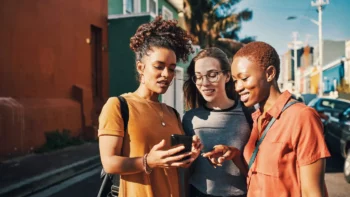
What Marketers Can Do to Tackle the Youth Mental Health Epidemic
Voxburner Content Team
We hosted a Deep Dive webinar exclusively for Voxburner+ members on the topic of Gen Z and Mental Wellbeing. The two-hour session featured a panel discussion with young leaders in the mental health space, a Q&A with the founder of peer support app MeeToo, and a discussion between youth mental health site The Mix and clothing brand A&F on how brands can get involved. We’ve collated some of the key takeaways and actionable ideas from the webinar to share with you here.
Provide support during troubling world events
When issues such as violence against Black people, women or transgender people are in the news, we need to be aware of how this can affect young people who belong to those groups. Being constantly confronted with reminders of their own vulnerability and the hatred that exists towards a group they are part of is upsetting and scary.
Student and founder of My Mind Matters Too, Meg Zeenat-Wamithi explained, “During Black Lives Matter a lot of young people were suffering. It was triggering that every conversation at work or with your friends was about race.” She praised an organisation called The Empowerment Group, which stepped forward during the BLM protests last summer to offer free counseling sessions for young Black people.
Listen to what your audience wants
There’s no point in launching a mental health campaign if it’s not going to have a substantial impact on their lives of the young people you’re aiming to help. To ensure that you’re catering to their real needs and delivering support in a way that works for them, it’s vital to hear directly from young people.
Chelsie James, creator of the blog Bereaved at 22 advised: “There are many things brands can do, like supporting hashtags, getting involved with key events throughout the year, collaborating with charities on campaigns. It’s about how brands listen to their consumers: conduct market research, and listen to the voice of your audience.”
Collaborate to increase your impact
No brand is going to solve this problem on their own. Tackling an issue as vast as the mental health epidemic will require collaboration and synced-up organisation to make a real difference. Meg Zeenat-Wamithi stated “collaboration and co-creation are the best things to do,” while The Mix’s Zoe Baillie explained what they look for when deciding whether or not to work with a brand.
She shared: “We get a lot of feedback before we enter into a relationship with a brand. We do have brands approach us that young people don’t want us to work with. We look at our ethics and values, and involve our beneficiaries, staff and volunteers in the decision making around which brands we work with. Hollister gave an honest background of what their strategy was and what their values were.”
Show your audience what you stand for
Young people like to buy from brands that share their own values, so it’s tempting for brands to try and appeal to all of them by chiming in on every issue. In fact, these messages only feel authentic when brands make clear what they stand for and what they don’t, even if they may risk losing some customers in the process.
Chelsie James gave the example of Gymshark, who demonstrated this perfectly: “Gymshark have really stood out from the rest of the gym brands. They got a lot of abuse on social media for using plus-size models and they said, if you don’t like it, you know where the unfollow button is. When brands use models with unrealistic shapes it makes me self-conscious, I can’t imagine wearing that and I’m put off buying it.”
Consider who you want to represent your brand
We believe that marketers should consider the impact on young people’s mental health of every campaign or marketing activity they conduct, and one example of this is choosing influencers to work with. These partners are a representation of your brand, and it’s important to ensure they share your values, so if you want to stand for protecting youth mental health, you should choose influencer who are on the same page.
Katie Adams from A&F Brands shared how this affected their decision-making: “It’s our brand purpose to connect with young people and help build their confidence. We weren’t looking to work with standard influencers, who talk about clothes regularly, but instead work together with The Mix to identify people who are going to connect best with young people, because they themselves are advocates for talking about mental wellness and disrupting the stigma around mental health.”
To watch last week’s Deep Dive and much more video on demand content, along with our back-catalogue of research reports, become a member of Voxburner+ today.



